While the pandemic posed unprecedented obstacles for sustaining performance excellence, results of a new Pulse Survey show clubs have been more than up to the task.
Management is evolving. New trends and insights provided by innovative strategies, new technology, societal shifts For the Excellence in Club Management theme of this issue of Club Trends, McMahon Group conducted one of its proprietary Pulse Surveys, to get club managers’ insights into how they now approach staff recruitment, training, motivation, recognition and other areas of human resources management to achieve maximum performance from their employees.
It was the first Pulse Survey McMahon has conducted on HR-related issues since 2018, and comparing the latest survey data to the responses to similar questions asked six years earlier reveals much about how clubs’ workplaces and workforces have changed dramatically in the post-pandemic era.
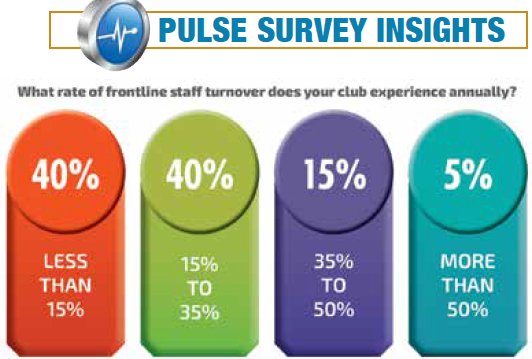
For example, today’s clubs are clearly wrestling with more challenges relating to overall staff turnover. Where the 2018 Pulse Survey showed that over 85% of respondents had annual frontline staff turnover of 35% or less, with nearly 50% having less than 15%, this year’s results (see chart at right) showed that only 40% now say they are able to hold their annual turnover rate under 15%, and only 80% to under 35%. As well, 15% reported they are now experiencing an annual turnover rate of between 35% and 50%, compared to just 2.3% with that level in 2018.
At the same time, comments received with responses to the turnover question in this year’s survey indicate that many clubs feel they are finally getting a better handle on the root causes behind the increased turnover that was generated by COVID-induced upheaval.
“Initially, [turnover] was much higher [after COVID], but it has begun to stabilize over the past several months,” said one respondent.
“We are finally fully staffed again this year,” said another. “For the first time in four years, I felt fully prepared for Easter and Mother’s Day.”
Highlights and additional insights from the latest Pulse Survey are presented in the following pages.
Profile of Respondents
Profile of Respondents Over 230 responses were received for the latest Pulse Survey, primarily from managers at country clubs but with significant representation from golf clubs, city/dining/athletic clubs and yacht clubs as well.
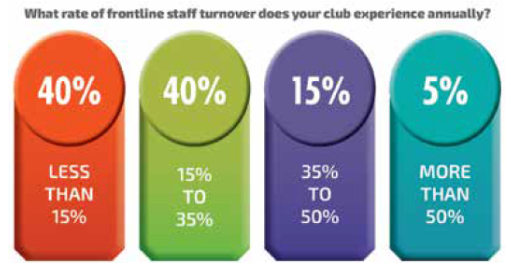
The majority of responses (45%) came from clubs with between 251 and 500 members in their main (full/regular) category, but representation was significant for both smaller and larger clubs, with another 44.5% of responses, collectively, coming from clubs with over 500 members and over 10% from clubs with more than 1,500 members.
Broken down by initiation fee, responses were again spread fairly evenly across the board, with the largest percentage (13.6%) coming from clubs with entry fees of between $20,000 and $30,000.
COVID’s Challenges
Confirming the results showing increased annual turnover rates compared to the Pulse Survey results from 2018, over a third of respondents to this year’s survey said they have had more difficulty controlling staff turnover post-COVID, while only a quarter said they have had success reducing it. Additionally, over two-thirds of respondents said they have had a harder time finding, hiring and managing qualified staff in the post-COVID era, and less than 10% said that it has been easier to do so (see chart, pg. 10).
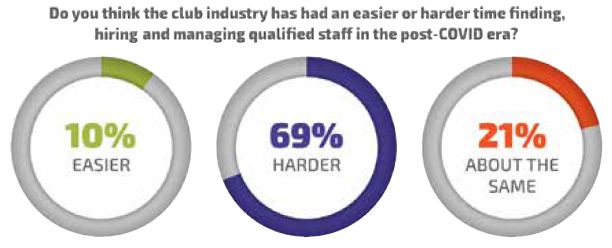
Asked which areas of club management have proved to be the most challenging for finding and retaining staff, food-and-beverage positions for both the front (66%) and back (58%) of the house were cited by a majority of respondents, and golf course maintenance positions were cited by over a third (34%) of respondents (see chart pg. 10). “While turnover has decreased overall, it has gone up for kitchen positions since COVID,” one respondent said. “Service staff and golf course maintenance are the hardest to hire,” said another.
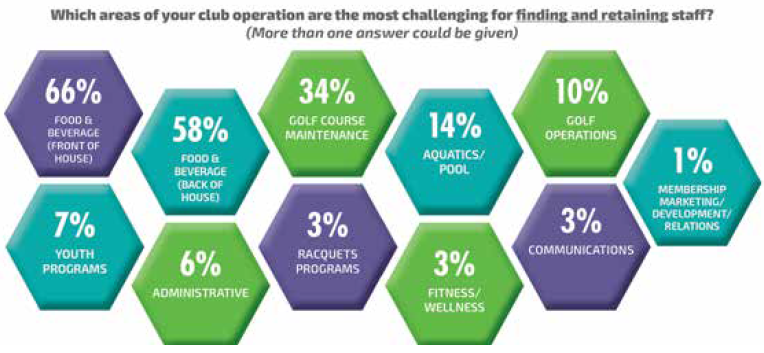
Help from HR
The 2024 survey also repeated questions asked in 2018 regarding clubs’ establishment and use of Human Resources departments and programs. Those questions yielded these comparative findings, which collectively indicate a growing emphasis within the club industry on elevating the HR function and formalizing HR procedures as a key to enhancing staff quality and performance:
Nearly 55% of responding clubs now have HR departments, compared to 48% in 2018.
Of the clubs that now have HR departments, over 20% now have three or more persons working in that department, compared to just over 10% of responding clubs with HR staffs of that size in 2018.
Among clubs with a full-time, department head-level person in charge of an HR department, a greater percentage (75%, vs. 71% in 2018) now have that person report to the club’s general manager/ CEO/COO, vs. a controller or CFO.
Asked if their club has succession plans in place for key positions, 47% said yes in 2024, compared to 39% in 2018.
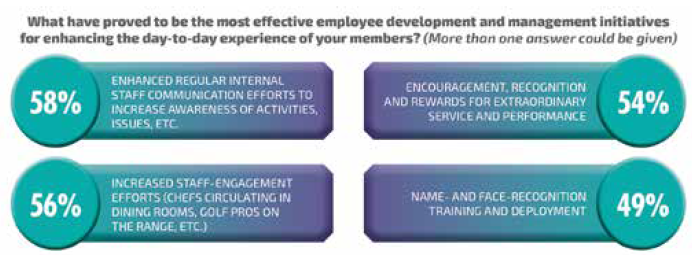
New Points of Emphasis
The 2024 survey asked which HR-related areas are now receiving special emphasis to help create, promote and ensure excellence in staff performance. These were the top answers received (percentage of respondents giving the answer shown in parentheses; more than one answer could be selected):
Compensation and benefits, including performance incentives (58%)
Recognition programs (49%)
More extensive initial training and onboarding programs (44%)
Expanded recruiting efforts beyond traditional avenues (42%)
More opportunities for continuing education, both internal and external (42%)
Special events, retreats and other team-building efforts (38%)
Employee counseling (32%) n Employee space improvements (breakrooms, lounges, libraries, etc.) (28%)
Job sharing, cross-training, reduced work weeks and other measures to promote increased job satisfaction and interest and enhance work-life balance (23.4%)
Asked for insights into what are proving to be the most effective employee development and management initiatives for enhancing the day-to-day experience of their club members, respondents to the 2024 survey cited these programs (percentage of respondents giving the answer shown in parentheses; more than one answer could be selected):
Increased staff-engagement efforts (chefs circulating in the dining room, golf pros on the range, videos sent regularly to the membership, etc.) (56%)
Encouragement, recognition and rewards for extraordinary service and performance (54%)
Name-and face-recognition training and deployment (54%)
The 2024 survey also asked what facilities are currently being provided to help promote employee comfort and productivity, and what new employee facilities or services are being planned or considered to help further enhance workforce satisfaction. While the responses about current facilities centered around what has largely come to be expected in the way of available staff amenities (lounges and breakrooms, dedicated dining areas, showers/lockers and housing where feasible), the second question produced a much more diverse set of new concepts for features and perquisites designed to engender and solidify staff engagement and loyalty (see sidebar, pg. 10).
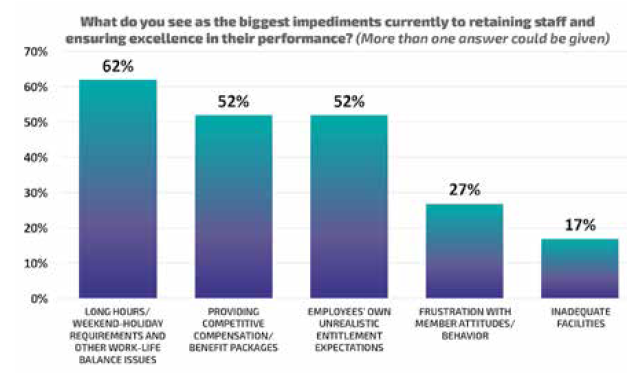
Remaining Hurdles
Overall, the 2024 Pulse Survey results showed that clubs have adopted many new approaches to staff development and management, to remain competitive in today’s vastly different employment environment and deliver optimal service and experiences to their memberships. At the same time, the survey highlighted some persistent realms of difficulties that club managers still encounter when trying to establish and ensure performance excellence throughout their operations. Asked to identify the biggest impediments that currently exist for retaining staff and having employees perform at the highest level, these top answers emerged (percentage of respondents giving the answer shown in parentheses; more than one answer could be selected):
Long hours/weekend-holiday requirements and other work-life balance issues (62%)
Providing competitive compensation/benefit packages (52%)
Employees’ own unrealistic entitlement expectations (52%)
Frustration with member attitudes/behavior (27%)
Inadequate facilities (17%)
Comments given with these answers (see sidebar pg. 9) provided further insights into the frustrations that many managers are encountering as they try to ingrain excellence throughout their organizations. Much of this frustration stems from a lack of support from club memberships that still fail to see the value and payoffs that increased attention to staff-related conditions and concerns can bring.
As one survey respondent said: “We’re developing a new building, and the members took space out of this redeveloped area so that the restroom facilities will be even smaller. Members still don’t see the value that the teams servicing them provide and how enhanced spaces for employees leads to a happier, more committed workforce. Heck, they even removed two offices I needed and made the [general manager’s] office smaller.”


